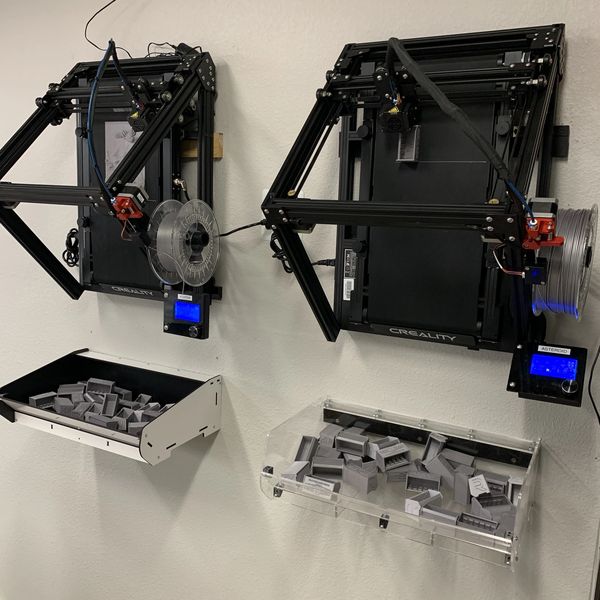
Wait, are wall-mounted 3D printers even possible?
As you can see in the image above, they most definitely can be.
There’s a bit of an assumption that 3D printers must operate in a totally level orientation. That is actually true for most 3D printing processes. For example, if you operate a resin 3D printer horizontally, or even slightly unlevel, the resin will pour out and produce a horrifying toxic mess.
But one 3D printing process, FFF, is actually quite amenable to non-horizontal operation.
Sideways 3D Printing
I first saw this effect five years ago when I witnessed a Mass Portal delta-style machine, the Pharaoh, operating sideways. This was a bit of a revelation for me, and I assume the same would be true for most people who operate FFF 3D printers: they are built to be horizontal and they operate horizontally.
But it doesn’t have to be so.
The reason for this unused capability is due to bed adhesion.
FFF Bed Adhesion
In the FFF process the print must strongly adhere to the print surface so that subsequent layers can be accurately placed. It turns out that the nozzle’s extrusion line does generate some sideways pressure on the print: imagine the extrusion line like a thread lightly pulling on the model as it moves.
Bed adhesion systems are designed to overcome these forces by using very strong adhesion. It’s not permanent adhesion, of course, because you do need to remove the print at some point. However, during 3D printing, due to glue, chemistry, heat or some combination thereof, the print should stick quite strongly.
This strong adhesion is usually greater than the force of gravity. This means that a properly tuned FFF 3D printer should be able to operate on an angle, sideways and even upside down. In fact, FFF 3D printers have flown on the International Space Station and run successfully in a microgravity environment.
Wall-Mounted 3D Printer
That free orientation capability is what makes the wall-mounted 3D printer concept work. In this example, Repkord has developed a mounting system for the Creality 3DPrintMill, a belt 3D printer.
One of the best features of a belt 3D printer is that it can operate continuously, 3D printing object after object until the filament spool is exhausted.
One “problem” with belt 3D printers is that they can thus produce copious quantities of small parts in a relatively short time. Belt printer operators aren’t standing by the machine 24/7, nor are they showing up after the “job ends” to pick up the print — because on a belt 3D printer, the “job” potentially never ends.
The solution is usually to place a bucket or box under the end of the belt to collect objects as they peel off the curved end of the belt. That works, but is often inelegant.
The wall mounted solution seems to be far more elegant. It takes up far, far less space and offers a way to have a low-footprint collection box. If you’re pressed for space you could mount them in a vertical column above each other.
Wall-Mounted 3D Printer Farm
That configuration could enable the creation of an extremely dense belt 3D printer farm, where all floor space would be optimally used. Let’s do some math.
On a standard wall it might be possible to place three units in a vertical column. For width, these are about 600mm wide, so let’s say we space them 1m apart. Thus on a 3m wall you could place nine of these belt 3D printers safely and take up only 4.5sm floor space.
That’s extremely dense. Now imagine a 5 x 3 m room. If we spaced these “printer walls” within the room at 1m intervals you could have six of them, giving a total of 54 belt printers in a relatively small room. If these machines could each produce a small part, say, every two hours, the room would be capable of producing 27 objects per hour, or 4,536 objects per week.
That’s quite incredible, and I am pretty sure someone is going to try doing this.
If they do, they’d better ensure the room has air conditioning.
Via Repkord
